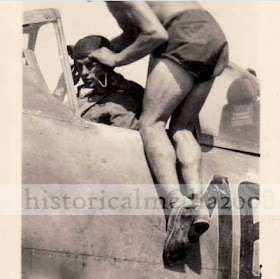Fw 190 As of the
Stabsstaffel JG 51. Click on the image to view large. In the first image below, second from the right (front, note white cross on the image) is Fw Fritz Lüddecke following his return from a sortie on 9 March 1943 during which he returned his second victory, shooting down a Pe 2. Lüddecke was awarded the RK posthumously on 18 November 1944 for his 50 victory claims and many
Jaboeinsätze (fighter bomber missions) with the specialised Jabo Fw 190s of the
Stabsstaffel JG 51. Lüddecke was KIA on 10 August 1944 when attempting an unsuccessful belly landing after being hit by anti-aircraft fire south-west of Wilkowischken. Alongside him in this photo is Fw Kuno Balz who was KIA barely a fortnight after this photo was taken (18 March 1943). Balz had 12 victory claims.
A-8 "schwarze 3" of the
Stabsstaffel JG 51 in Memel during September 1944. Pilot is Uffz. Helmut Johne who was KIA in early February 1945 with eight victory claims. Note yellow spinner and forward cowl.
Below, "Black 8" of the
Stabsstaffel JG 51 probably in Memel, September 1944. Pilot in the cockpit is Lt. Günther Heym who survived the war with 20 victory claims. Awarded the
Ehrenpokal.
Fw 190 A-8
Stabsstaffel JG 51 in Insterburg, October 1944. Left, 1 Wart Uffz. Helmut Lohse and pilot Fw Günther Granzow who survived the war with 12 victory claims.
Two 'unknown'
Stabsstaffel JG 51
Flugzeugführer (pilots) on the left, Fw Walter Brake in Krakau, at least two victory claims and Ofw Baumgarten (3 claims)
Lt. Wilhelm Hübner (above) was awarded the
Ritterkreuz on 28 February 1945 for 62 victories but was KIA on 7 April 1945 in the vicinity of Neukuhren after taking a direct hit from anti-aircraft fire. Here he is seen in October 1944 in Memel wearing the DKiG on his tunic, awarded on 1 October 1944. The
Deutsches Kreuz in Gold usually preceded the award of the RK..
All images above currently on offer via Michael Meyer's Ebay sales
http://www.ebay.de/sch/macflly41/m.html?item=380719023936&pt=Militaria&hash=item58a49f4740&rt=nc&_trksid=p2047675.l2562
The Stabsstaffel JG 51 (formerly 6./JG 51) was the only unit of JG 51 to remain on Fw 190s throughout the Geschwader's time in the East. Their Staffel markings consisted of Kommodore style insignia; a bar either side of the fuselage cross with the chevron replaced by a black individual number. A number of Stabsstaffel JG 51 Fw 190s featured personal markings on their aircraft, mostly pilots' girlfriend’s names (as on 'black 6-' below "Hanni") . The Stabsstaffel JG 51 became a renowned exponent of close support and fighter-bomber missions during the retreat from Russia and a number of their aircraft sported yellow spinners and cowls which may have been a recognition aid for German flak. More Stabstaffel JG 51 Fw 190s below including 'Black 6' and 'Black 16'. Note the yellow spinner and cowl in the next two images. The yellow extends across the base of the prop blades.

















































